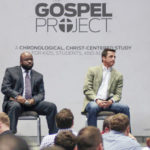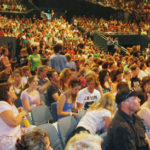NASHVILLE, Tenn.—More than 50 years after Martin Luther King Jr. declared 11 a.m. on Sunday the most segregated hour of the week, racially diverse congregations remain more dream than reality for most Protestant pastors, research reveals.
More than eight in ten—85 percent—say every church should strive for racial diversity, according to a survey from Nashville-based LifeWay Research. But few have diverse flocks, with most—86 percent—acknowledging their congregation is predominately one racial or ethnic group.
 Diverse churches remain rare largely because of human nature, said Ed Stetzer, president of LifeWay Research.
Diverse churches remain rare largely because of human nature, said Ed Stetzer, president of LifeWay Research.
“Everybody wants diversity,” Stetzer said. “But many don’t want to be around people who are different.”
The research study also found 91 percent say, “Churches should reflect the racial diversity in their community.” And 79 percent believe their congregations look very similar to the people in their neighborhood.
But Mark DeYmaz, pastor of Mosiac Church, a multi-ethnic congregation in Little Rock, Ark., is skeptical. DeYmaz, who also helped found the Mosaix network of multi-ethnic churches, said pastors aren’t always aware how diverse their communities have become.
“Pastors would do well to look into the diversity of nearby public schools and gauge this against the diversity of their church to really understand their context,” he said. “They might, too, spend one hour sitting at the front of the … local grocery to see if in fact their church reflects the community.”
America is becoming increasingly diverse
Data from the U.S. Census Bureau shows America is becoming increasingly diverse.
Sign up for our weekly edition and get all our headlines in your inbox on Thursdays
About 17 percent of Americans identify as Hispanic. African-Americans make up 13 percent of the population, followed by Asian-Americans (5 percent), and 1 percent Native American or Native Alaskan. Another 2.4 percent identify with more than one racial group.
Non-Hispanic whites make up 63 percent of the population. That number drops to about 49 percent for children under 5 years old, according to a recent report from the Associated Press.
DeYmaz sees the widespread support for the idea of diversity in the LifeWay Research poll as a good sign.
“We have gained tremendous ground over the past 10 years or so,” DeYmaz said.
 Ten years ago, the first meeting of the Mosaix network drew about 30 people, he noted. A similar meeting in November 2013 drew more than 1,000.
Ten years ago, the first meeting of the Mosaix network drew about 30 people, he noted. A similar meeting in November 2013 drew more than 1,000.
In the past, DeYmaz and other leaders in multi-ethnic churches spent much of their time trying to convince other pastors about the need for diversity. Now they spend more time talking with pastors about strategies for creating diverse churches, he said.
“Increasingly, their question is not, ‘Why should I?’ but ‘How can I?’” he said.
Derwin Gray, pastor of Transformation Church, a multi-ethic congregation in Indian Land, S.C., said if pastors want a diverse congregation, they need to change their sermons.
He worries pastors support diversity for pragmatic rather than theological reasons. Early Christian churches were racially diverse, but that idea was lost as churches divided along racial and ethnic lines, Gray said. He wants pastors to go back to the Bible to discover why churches should be diverse.
‘The gospel brought people together’
“We shouldn’t long for racial diversity. We should long for the proclamation of Jesus, which creates ethnic diversity,” he said. “The Apostle Paul didn’t start one church for Jews and one church for Gentiles in the New Testament. The gospel brought people together.”
More focus on racial diversity in church could find a welcome audience. A second LifeWay Research survey—this time an online panel of 1,036 Americans—found three quarters of respondents (78 percent) said, “Every church should strive for racial diversity.”
More than half—51 percent—said they would be most comfortable visiting a church where multiple ethnicities are well represented. Three quarters also said churches should reflect the diversity of their communities.
Some signs indicate a growing number of diverse churches in the United States. The 2010 Faith Communities Today survey, which included 11,000 congregations of different faiths, found about 12.5 percent of Protestant churches were multi-ethnic. That means in those churches, no one ethnic group makes up more 80 percent of the congregation.
Hard work ahead
Moving diversity from a dream to a reality will take hard work, DeYmaz said.
“Wishful thinking in this regard will not bring increasing diversity to local churches for the sake of the gospel,” he said.
LifeWay Research conducted the telephone survey of Protestant pastors Sept. 4-19, 2013. Researchers randomly drew the calling list from a stratified list of Protestant churches and conducted each interview with the senior pastor, minister or priest of the church called. The survey weighted responses to reflect the geographic distribution and denominational groups of Protestant churches. The completed sample is 1,007 phone interviews.
LifeWay Research conducted the online survey of adult Americans Sept. 6, 2013. Researchers invited a sample of an online panel representing the adult population of the United States to participate and weighted their responses by region, age, ethnicity, gender and income to reflect the population more accurately. The completed sample is 1,036 online surveys.
In both surveys, the methodology and sample size provides 95 percent confidence the sampling error does not exceed plus or minus 3.1. Margins of error are higher in sub-groups.














We seek to connect God’s story and God’s people around the world. To learn more about God’s story, click here.
Send comments and feedback to Eric Black, our editor. For comments to be published, please specify “letter to the editor.” Maximum length for publication is 300 words.